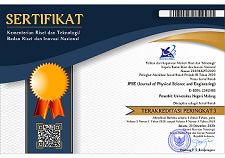Comparative Study on Mechanical Properties of Waste Composite Materials for Bricks Application
Abstract
This study discusses mechanical properties and analysis of composite materials to develop building bricks for structural lightweight concrete replacement applications made from three different waste materials, i.e. sawdust, polyethylene terephthalate (PET) plastic bottle, and used diaper. All waste materials are used to mixture composite, as cement replacement, with a mixture of 0, 5, 10, 15, and 20 percent of the total weight. This study uses a quantitative method with the sample used as cylindrical tube with 20 mm of diameter and 40 mm of height. Tests were carried out in the form of compressive and specific gravity tests to determine the mechanical and physical properties of the composite material. The use of waste materials as mixtures for composite manufacture with a water per cement ratio of 0.4 at the age of 28 days results in the best compressive strength of 20.70 MPa (5 percent of sawdust), 33.04 MPa (5 percent of PET), and 18.05 MPa (5 percent of used diaper). The density value shows that the addition of waste materials tends to decrease the weight of the composite result. Based on these results, it can be concluded that the use of waste composite materials is a potential replacement for lightweight structural concrete as an effort to reduce the cement requirement for building material applications.
Keywords
Full Text:
PDFReferences
M. Á. Sanjuán, C. Andrade, P. Mora, and A. Zaragoza, “Carbon dioxide uptake by cement-based materials: A Spanish case study,” Appl. Sci., vol. 10, no. 1, p. 339, Jan. 2020, doi: 10.3390/app10010339.
M. M. H. Khan, J. Havukainen, and M. Horttanainen, “Impact of utilizing solid recovered fuel on the global warming potential of cement production and waste management system: A life cycle assessment approach,” Waste Manag. Res., vol. 39, no. 4, pp. 561–572, 2021, doi: 10.1177/0734242X20978277.
R. M. Andrew, “Global CO2 emissions from cement production,” Earth Syst. Sci. Data, vol. 10, no. 1, pp. 195–217, Jan. 2018, doi: 10.5194/essd-10-195-2018.
G. U. Fayomi, S. E. Mini, O. S. I. Fayomi, and A. A. Ayoola, “Perspectives on environmental CO2 emission and energy factor in cement industry,” IOP Conf. Ser.: Earth Environ. Sci., vol. 331, no. 1, p. 012035, Sep. 2019, doi: 10.1088/1755-1315/331/1/012035.
A. V. Lăzărescu, H. Szilagyi, C. Baeră, and A. Ioani, “The effect of alkaline activator ratio on the compressive strength of fly ash-based geopolymer paste,” IOP Conf. Ser.: Mater. Sci. Eng., vol. 209, no. 1, p. 012064, Jun. 2017, doi: 10.1088/1757-899X/209/1/012064.
T. Lingyu, H. Dongpo, Z. Jianing, and W. Hongguang, “Durability of geopolymers and geopolymer concretes: A review,” Rev. Adv. Mater. Sci., vol. 60, no. 1, pp. 1–14, Jan. 2021, doi: 10.1515/rams-2021-0002.
N. B. Singh and B. Middendorf, “Geopolymers as an alternative to portland cement: An overview,” Constr. Build Mater., vol. 237, p. 117455, Mar. 2020, doi: 10.1016/j.conbuildmat.2019.117455.
T. Luukkonen, Z. Abdollahnejad, J. Yliniemi, P. Kinnunen, and M. Illikainen, “One-part alkali-activated materials: A review,” Cem. Concr. Res., vol. 103, p. 21–34, Jan. 2018, doi: 10.1016/j.cemconres.2017.10.001.
Z. Tang, W. Li, Y. Hu, J. L. Zhou, and V. W. Tam, “Review on designs and properties of multifunctional alkali-activated materials (AAMs),” Constr. Build Mater., vol. 200, pp. 474–489, Mar. 2019, doi: 10.1016/j.conbuildmat.2018.12.157.
L. N. Sambe, B. Origbo, S. Gbande, and P. U. Ande, “Assessment of wood waste generation and utilization in Makurdi metropolis: Implication for sustainable management of forest resources,” J. Res. For. Wildl. Environ., vol. 13, no. 1, pp. 188–196, May 2021.
S. Adhikari and B. Ozarska, “Minimizing environmental impacts of timber products through the production process “From Sawmill to Final Products”,” Environ. Syst. Res., vol. 7, no. 1, pp. 1–15, Apr. 2018, doi: 10.1186/s40068-018-0109-x.
K. Choudhary, K. Sangwan, and D. Goyal, “Environment and economic impacts assessment of PET waste recycling with conventional and renewable sources of energy,” Procedia CIRP, vol. 80, pp. 422–427, 2019, doi: 10.1016/j.procir.2019.01.096.
S. C. Khoo et al., “Recent technologies for treatment and recycling of used disposable baby diapers,” Process Saf. Environ. Prot., vol. 123, pp. 116–129, Mar. 2019, doi: 10.1016/j.psep.2018.12.016.
S. Zuraida, A. Primasetra, R. B. Margono, and A. Harmaji, “The application of plastic composite panel for prefabricated low costs housing in Indonesia: A green construction design proposal,” J. Asian Inst. Low Carbon Des., pp. 605–610, 2020.
A. Harmaji and S. Zuraida, “Green construction material: Polyethylene waste reinforce concrete for panel application,” Int. J. Built Environ. Sci. Res., vol. 3, no. 1, pp. 1–6, Jun. 2019, doi: 10.24853/ijbesr.3.1.1-6.
Standard Test Method for Compressive Strength of Cylindrical Concrete Specimens, C39/C39M-03, ASTM International, West Conshohocken, PA, USA, Jul. 2003.
S. Na, S. Lee, and S. Youn, “Experiment on activated carbon manufactured from waste coffee grounds on the compressive strength of cement mortars,” Symmetry, vol. 13, no. 4, p. 619, Apr. 2021, doi: 10.3390/sym13040619.
S. Beddu, D. Mohamad, F. M. Nazri, S. N. Sadon, and M. G. Elshawesh, “Properties of self-curing high strength concrete by using baby polymer diapers,” MATEC Web of Conf., vol. 203, p. 06022, Sep. 2018, doi: 10.1051/matecconf/201820306022.
A. S. Benosman et al., “Plastic waste particles in mortar composites: Sulfate resistance and thermal coefficients,” Prog. Rubber Plast. Recycl. Technol., vol. 33, no. 3, pp. 171–202, Aug. 2017, doi: 10.1177/147776061703300304.
M. Thiam, M. Fall, and M. S. Diarra, “Mechanical properties of a mortar with melted plastic waste as the only binder: Influence of material composition and curing regime, and application in Bamako,” Case Stud. Constr. Mater., vol. 15, p. e00634, Dec. 2021, doi: 10.1016/j.cscm.2021.e00634.
Copyright (c) 2022 Siswanti Zuraida, Andrie Harmaji, Sastita Pratiwi, Xevna De Elshinta Arellsya Ruitan, Astrid Nadya Anggraini, Yudea Sisti Kurniadevi, Bart Julien Dewancker

This work is licensed under a Creative Commons Attribution-ShareAlike 4.0 International License.
This work is licensed under a Creative Commons Attribution-ShareAlike 4.0 International License




















